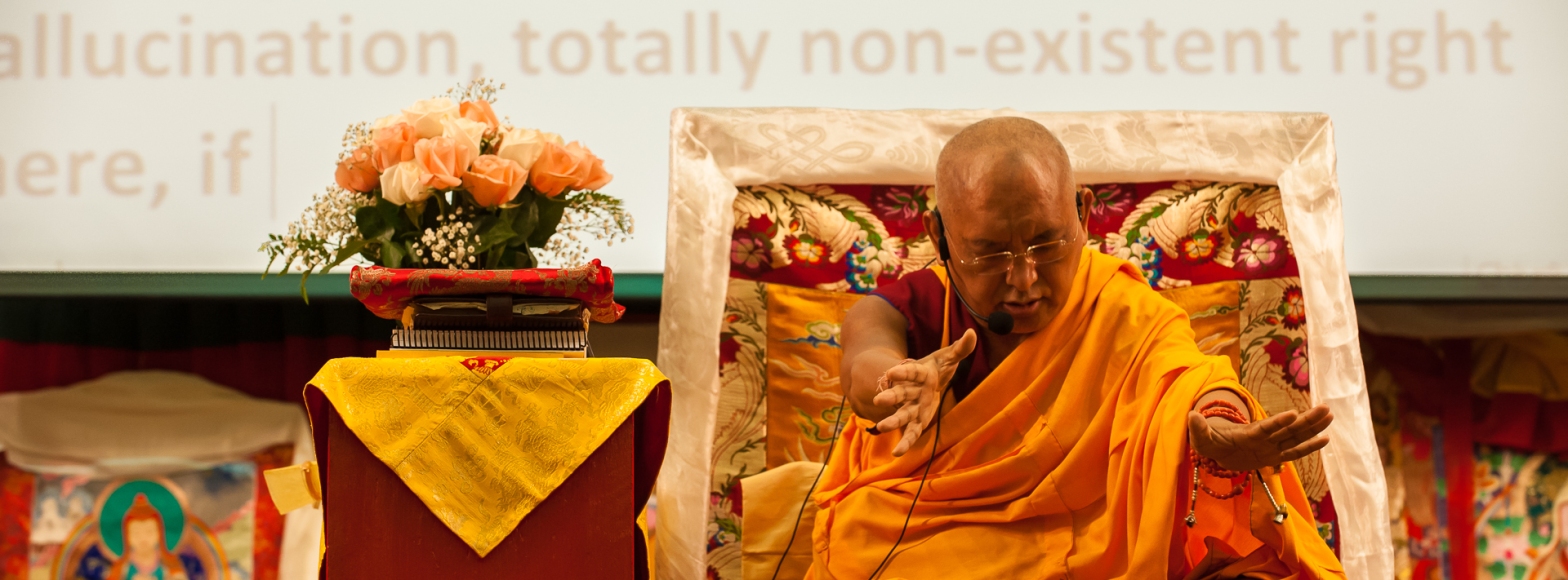A Blessing from His Holiness
Four Wrong Concepts is a teaching on four mistaken ways of viewing ourselves and the world that have kept us trapped and suffering in cyclic existence from beginningless time. The main wrong concept is ignorance—the self-grasping of the person and of the aggregates—which is the originator of the others. Four Wrong Concepts is a special motivation used by Lama Zopa Rinpoche for taking the eight Mahayana precepts. Edited by Venerable Sarah Thresher with Megan Evart.

Today I thought to read a motivation that His Holiness the Dalai Lama taught one time when giving the eight Mahayana precepts in Dharamsala. His Holiness gave the precepts quite a number of times. Once when I was staying in Dharamsala for a few months, His Holiness requested his senior tutor, His Holiness Ling Rinpoche, to give the eight Mahayana precepts in the Temple. Inside and outside the temple was filled with monks and lay people and His Holiness took the precepts along with everybody else. His Holiness Ling Rinpoche gave a motivation as well as the definition of each of the four major and four secondary vows.
Another time His Holiness gave the precepts, not inside but outside the temple. The motivation was very effective so I got the tape and wrote it down. After listening to that motivation, my mind kind of changed and I could think of others. I think it was just a blessing, not the actual realization, and of course it didn’t last long because I didn’t put effort into it, even though I planned to do so.
THE FOUR WRONG CONCEPTS: A SHORT MEDITATION
I and all sentient beings have been suffering in samsara from beginningless rebirths up to now because of these four wrong concepts:
First Wrong Concept
While the aggregates are not I (the self),
Because of looking at the aggregates as the self and being attached,
I and all sentient beings have been born and suffered in samsara
Numberless times from beginningless rebirths up to now.
Second Wrong Concept
While samsaric pleasure is only suffering,
Because of looking at samsaric pleasure as real happiness and being attached,
I and all sentient beings have been born and suffered in samsara
Numberless times from beginningless rebirths up to now.
Third Wrong Concept
While this body is dirty,
Because of looking at the body as completely clean and being attached,
I and all sentient beings have been born and suffered in samsara
Numberless times from beginningless rebirths up to now.
Fourth Wrong Concept
While all compounded phenomena are in the nature of impermanence,
Because of looking at compounded phenomena as permanent and being attached,
I and all sentient beings have been born and suffered in samsara
Numberless times from beginningless rebirths up to now.
If I continue to follow these four wrong concepts, I will experience unimaginable sufferings endlessly.
Letting Go of the I and Cherishing Others
Just freeing myself from the ocean of samsaric sufferings and its causes is not enough.
All sufferings, obstacles, misfortunes and undesirable things come from cherishing the I, while all my past, present and future happiness, liberation and enlightenment comes from cherishing and wanting to benefit others. Therefore the I is something to let go of, while other sentient beings are unbelievably precious, kind and dear and to be cherished.
In order to cause all sentient beings to have happiness in this life and future lives, as well as liberation from samsara and enlightenment, I myself must first achieve enlightenment and for this reason I am going to take the eight Mahayana precepts.

First Wrong Concept
Mistaking the Aggregates for the Self
The first wrong concept is mistaking the aggregates for the self.
While the aggregates are not I (the self),
Because of looking at the aggregates as the self and being attached,
I and all sentient beings have been born and suffered in samsara
Numberless times from beginningless rebirths up to now.
There is no I or self inside this body. The body is not the self, nor is the mind. To elaborate by going through each of the five aggregates: form is not I, feeling is not I, recognition is not I, the compounding aggregates are not I, and consciousness is not I. None of these five aggregates is the I or the self and even all together they are not the self. The aggregates themselves are not I, nor can I be found on the aggregates. Nowhere from the tips of your hair down to your toes can you can find the I, the self. (The “I,” or “self,” are the same thing.)

What can’t be found are two things. First, the real I that you believe right now is sitting on a cushion taking the eight Mahayana precepts: “I am here in a hall in North Carolina taking the eight Mahayana precepts.” That is the “real” I and it can’t be found. “Real” means “not merely labeled by the mind,” which means it is “existing from its own side.” When ordinary people call something “real,” they are actually talking about the object to be refuted (Tib: gag-cha). The object to be refuted is something that appears to the hallucinated mind to “exist from its own side” and is held by ignorance as one hundred percent true, but in reality it is not there. In everyday life, when people use the common word “real,” what they are referring to is actually the object to be refuted.
Therefore, this real I that you believe is taking the precepts and the real I that I believe is giving them is not there. Well, I can’t say that everybody in the hall is thinking that way! But anyway, in reality it is not there. There is no such real I giving the eight Mahayana precepts and no such real I taking them. It can’t be found. Nowhere from the tips of your hair down to your toes can that be found.
Second, not only can that real I not be found, but you can’t even find the merely imputed I that does exist. Even that can’t be found. You can find it in the United States and right now you can find it in this hall but you can’t find it on these aggregates. If you look for the merely labeled I, you can’t find it.
WHICH I IS TO BE REFUTED?
So there is a question: When you look for the I and can’t find it, is that the definition of realizing emptiness? My view is that that needs to be checked.
The text mentions three I’s: The merely labeled I; the real I that is not merely labeled by the mind but existing from its own side; and the general I, the I that is not specifically merely labeled or truly existent, it is just I.
“When you look for the I and can’t find it, is that the definition of realizing emptiness?”
These three are basically different ways an individual can view the I. By looking at the I as merely labeled, we can specify that there is a “merely labeled I”—which actually accords with reality—then apply the label “merely labeled I” and look for it. Then we can specify that there is a “real I” or “truly existent I”—the I we believe is inside this body and we feel to be something very truly existent from its own side—then apply the label “truly existent I” and look for it. Then when you are not thinking of the I as being either truly existent or merely labeled but just I, that is the general I. For example, you can look for the truly existent book, the merely labeled book, or just the general book without either of those being specified.

So when we look for the I and can’t find it, which I are we talking about? That needs to be checked because neither the truly existent I nor the merely labeled I can be found, but if you look for the merely labeled I or the general I on these aggregates and can’t find them, that becomes falling into nihilism.
In the lam-rim it is explained that if you look for the vase—not the “truly existent” or “real” vase that is the object to be refuted, but just “the vase”—at the end of the analysis when you can’t find the vase anywhere, it is not clear what the vase is, because you didn’t touch the object to be refuted. Then you fall into nihilism or destroy dependent arising.
The first of the four vital points of analysis is “understanding the object to be refuted.” The reason that has to comes first is because it makes no sense to look for the merely labeled I or general I and not find it. Recently I checked and saw a few paragraphs in different places talking about this mistaken way of analyzing. This is analysis, but it is done in the wrong way because the object to be refuted is missed out. Because the object to be refuted is not touched, the result is unclear and you can’t point out what the vase is. You cannot come to the conclusion that the vase exists as a dependent arising, which is its conventional truth, or the “truth for the all-obscuring mind” (Tib: kün-dzob den-pa).
Analyzing this way doesn’t support dependent arising but only destroys it, therefore you are lost! This kind of analysis is not meditating on emptiness. Meditating on emptiness should harm ignorance, but this doesn’t harm ignorance; ignorance is left there. Therefore, we need to be very specific about exactly which I it is that, when we look for it and can’t find it, means we are seeing emptiness. Anyway, this is just a tiny drop to give you some idea.
The real I is totally non-existent from its own side
THE REALIZATION OF EMPTINESS
Therefore, the real I that is now taking the eight Mahayana precepts and the real I that is now giving them are not there. That real I can’t be found in this body or on these aggregates. It is totally empty. It has total non-existence from its own side. It is totally non-existent right there from where it is appearing to your hallucinated mind.

Normally I say that this is my mudra for meditating on emptiness. The mudra [for the object to be refuted is to bring your hands toward yourself palms facing upwards] expressing that the real I appears to exist from there, from its own side. Then the mudra for seeing emptiness is [to turn your palms downwards and move the hands down away from yourself] showing that the real I is totally non-existent, right there from where it is appearing. It is totally non-existent right there.
As sentient beings, everything appears to us to be truly existent. Only in meditative equipoise with the wisdom directly perceiving emptiness is there no truly existent appearance and no hallucination. Otherwise, even when arising from that concentration, hallucination is there again. The truly existent view ceases only when the subtle defilement of ignorance—the negative imprint that projects the truly existent view—is ceased and there is no more concept of true existence. Buddha doesn’t have dualistic view, the truly existent view, but we sentient beings do and that is why for us there is always the appearance of a truly existent I. The I appears to us to be truly existent and because of not having realized emptiness, we hold to its existing that way.
After realizing that the I is empty, there is no longer the concept holding it to be truly existent. The simultaneously born concept of true existence is still there—that remains right up to the eighth ground—but not the clinging to true existence. The difference between the way of apprehending an object before realizing emptiness and after realizing it is like the difference between the sky and the earth. Before realizing emptiness, there is a strong holding on to true existence. A person who hasn’t realized emptiness apprehends the I to be truly existent and clings strongly to that. But after realizing the I to be empty, that total holding on to the I as truly existent is no longer there.
It is like looking back after crossing over the sand and seeing a mirage. The sunlight hitting the sand creates a vision of water and it really looks like there is water. But because you just came from there, you have the understanding that there is no water there. There is an appearance of water but at the same time you have the realization that there is no water. There is no clinging or total holding on to there being water.
THE EVOLUTION OF SAMSARA AND THE SUFFERING OF THE SIX REALMS
This I is totally empty. It is totally non-existent. Not only now, not only from last night, not only from birth, but from beginningless time. It has been empty and non-existent from the beginning. It never came into existence. But while it is like this, we have the hallucination that it exists from its own side.
This I has been totally non-existent from the beginning
The I that is just this second merely imputed by the mind, the very next second appears back to the hallucinated mind as not merely labeled. That appearance is a mental fabrication, but we let the mind hold onto it as one hundred percent true and in that moment, we create the root of samsara, ignorance.
This happens because we have been following ignorance and have been under the control of ignorance from beginningless rebirths. Ignorance has been our guru and we have been listening to everything it says with total trust up to now. Because of that, all the other negative emotional thoughts and wrong concepts arise: anger, attachment and ignorance along with the many different branches and types of these three poisonous minds. It is said that 84,000 teachings were given by the Buddha because, when elaborated, there are 84,000 different types of delusion.
“The I that is just this second merely imputed by the mind, the very next second appears back to the hallucinated mind as not merely labeled…
Ignorance motivates karma, which plants a karmic seed on the mere I. This is according to the Prasangika school, but how can an imprint be left without the continuum of the mind? Anyway, from that seed, rebirth is produced. It is because of this ignorance—the self-grasping of the person and self-grasping of the aggregates—that we have been suffering in samsara from beginningless rebirths up to now.
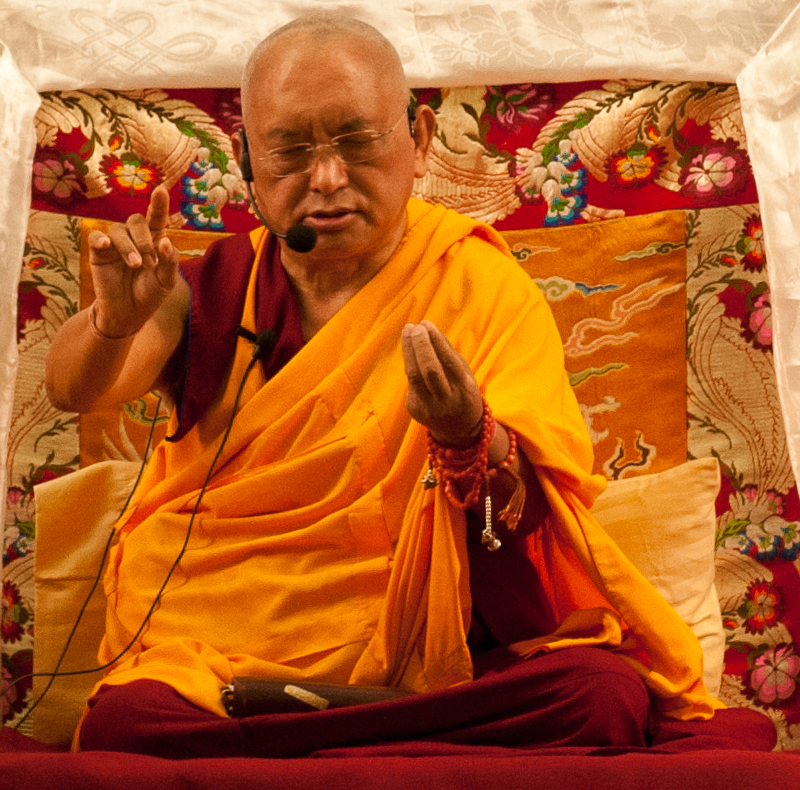
…we let the mind hold onto it as one hundred percent true and in that moment, we create the root of samsara, ignorance.”
Numberless times we have been born in each of the hell realms—the eight major cold hells, the eight major hot hells and the neighboring hells—from beginningless rebirths.Numberless times we have been born in the hungry ghost realm. Hungry ghosts experience the heaviest suffering of hunger and thirst for hundreds, thousands and even tens of thousands of years. They cannot find even one drop of water, not even dampness on the ground or even a spoonful of food for hundreds of thousands of years. It is the most unbearable suffering and we have been born in that realm and experienced it numberless times from beginningless rebirths.
Numberless times we have been born as animals and experienced the suffering of being extremely foolish and ignorant, as well as the unbelievably, unbelievably heavy suffering of being eaten alive. Wherever an animal is, its enemy is right there. Whether it is in the water, in the forest or underground, due to karma, wherever the animal is, its enemy is always nearby and it can be eaten any time.

In recent years I have been telling people that some time ago, when I was in an airplane, the thought came to me that when you look down at the ocean it seems very peaceful and calm, but when you think about the creatures that live in the water—wow, what suffering! What unimaginable suffering! There are big ones the size of a mountain that eat an unbelievable number of small ones. They eat whatever comes next to their mouth. Then there are many small ones who feed off the bodies of the big ones.Animals are constantly running in fear of being eaten. While they are escaping from their enemies, they’re looking for other animals to eat at the same time. It is just amazing; an unbelievable state of fear. Look at the birds. When a bird lands on the ground to eat food, it looks this way and that in every direction. You have to understand why—there is always fear. Wherever an animal is, its enemy comes. At the moment, we are not living with the constant fear of being eaten alive as we run to eat another creature alive. There are many human beings in this world who do eat creatures alive, but we are not doing that because we have met with the teachings of the kind, compassionate Buddha.
“Ignorance has been our guru and we have been listening to everything it says with total trust up to now.”
It is just amazing that we have not been born as those animals. Wow! It is just amazing that we have such unbelievable comfort and pleasure, especially the freedom and opportunity to practice Dharma. Like today, for example, right now taking the eight Mahayana precepts and doing retreat with lam-rim meditation and tantric practice, the quickest path to enlightenment. On the foundation of lam-rim we do the Guru Puja, which is the quickest way to achieve enlightenment. It has so many methods to purify obstacles and collect extensive merits, the necessary conditions. It is just amazing. We do not realize enough the situation those animals are in, all their continuous suffering and fear. We are simply not aware. We have such unbelievable comfort and pleasure that we can’t imagine it. We are totally spoiled and pampered—yet we are still unable to practice Dharma.
We have been born as all those different creatures living in the ocean numberless times. We have been born as whales the size of mountains and as tiny creatures that can only be seen through a microscope. We have been born as jellyfish and have been eaten numberless times. We have continuously suffered all of this numberless times from beginningless rebirths.
Even the animals that live with human beings have unbelievable suffering. They suffer from heat and cold, from being tortured, made to carry heavy loads and pull carriages. I see many beasts in India with their noses running and breathing “haaah haaah” because the load they are pulling is too heavy. Horses are used as long as they can be ridden and cows as long as they can produce milk, but when they are old and no longer useful they are killed. Cows are slaughtered for their meat and, although it’s not common, in Mongolia and some other countries they do eat horsemeat and drink mare’s milk.
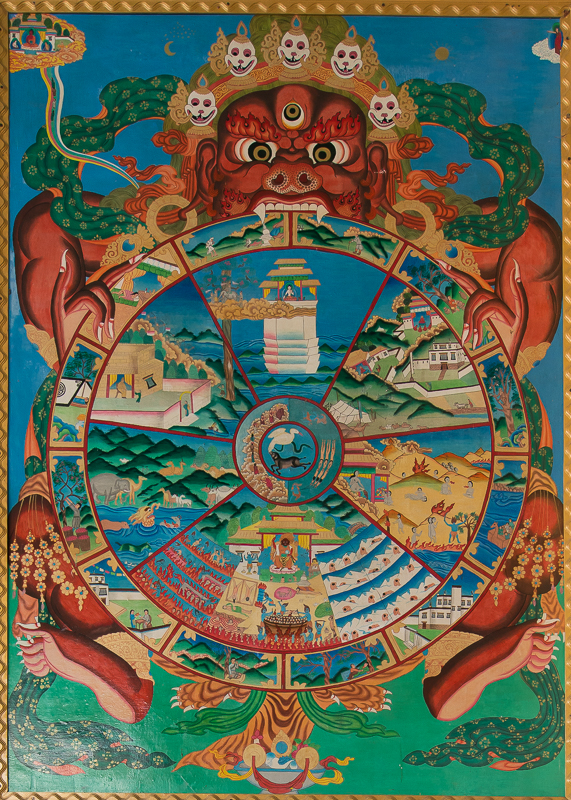
These animals cannot say anything. They have no freedom. They cannot express their feelings or say how much they are suffering. Can you imagine the difference between us as human beings and them? Wow! We don’t have the kind of problems they face for even a day. Therefore, if we make no use of this incredible life we have now with all its comfort, wealth and so on to practice Dharma and instead waste it—there is no greater loss. I am not going to go through all the quotations in A Guide to the Bodhisattva’s Way of Life, but Shantideva says (4:18):
If I don’t collect merit
While I have the fortune to enjoy virtue,
What can I do when I am born totally ignorant
And suffering in the lower realms?
If we don’t practice Dharma, purify, collect merit and attain the path now while we have this incredible opportunity, what will we do when born in the lower realms due to negative karma collected from beginningless rebirths and which we have still not purified or finished experiencing? Nothing. There is nothing that can be done in the lower realms, except just suffer for eons and eons and eons until the karma finishes.
“We are totally spoiled and pampered—yet still unable to practice Dharma.”
Numberless times we have been born as human beings and suffered. Humans have eight types of suffering. In Lama Tsongkhapa’s Great Treatise on the Stages of the Path to Enlightenment, these eight are each explained in five outlines to give a general idea. There is the suffering of birth, old age, sickness, death, worry and fear about meeting what you don’t want, not being able to find what you do want, not getting any satisfaction when you do find what you want and the suffering of the aggregates. The Rolling Stones’ singer expressed our inability to find satisfaction exactly from his own experience when he sang, “I can’t get no satisfaction.” He was somebody who was famous throughout the world, had a good reputation, wealth, friends and everything else, but he could not get any satisfaction from all of this.
Numberless times we have been born as suras and asuras and suffered. The mental suffering of the suras when they experience the five signs of nearing death is much heavier than the physical sufferings of the hell beings.
For example, sometimes I think that beggars who live on the street have not that much worry. Every day they beg for some food and live on that. They don’t have to worry about having a bad reputation or not being richer or better than others like wealthy people with businesses. Millionaires, billionaires and zillionaires have all that wealth and huge mansions, but so much worry.
Recently I saw a very wealthy American man on TV showing off his house. He has a mansion built on the water by the side of a lake and he was showing off all the many rooms and beds and boats and comfort. The good thing about being wealthy is that even if you don’t have the Dharma, you can help by doing good things for others with a sincere heart and compassion. Otherwise, there is nothing, just a lot of worry and fear about your business or reputation.
Wealthy people are always anxious and afraid that somebody else will become richer or more powerful and that they will lose their reputation or wealth. Even though they already have enough money for many, many lifetimes, still they have an unbelievable amount of anxiety. There are many business problems at work, relationship problems at home and constant pressure and stress. The beggar on the street doesn’t have that much concern.
“How wonderful their lives are!”
When Gelek Rinpoche was living in Delhi, he mentioned during teachings that the poor laborers working outside under the hot sun building roads or doing construction work look up through the windows of the large houses and see the air conditioning and fans. For them it seems like heaven and they think, “Those people have so much comfort and pleasure! How wonderful their lives are! They have no problems, only happiness!” At the same time, the wealthy people living in the houses look down at the laborers and think, “Those people working on the road have such a good, simple life with no heavy responsibilities or problems!” They are attracted to the poor people’s lives because they have so many business and relationship problems and so much worry and fear.
In a similar way, Kyabje Chöden Rinpoche explained that the mental suffering of the devas is heavier than the physical suffering of animals.
Numberless times we have been born and suffered like this in samsara due to ignorance, looking at the aggregates as being the I, the self, when in reality there is no I or self. There are other wrong concepts but this is the main one and the originator of all the others.
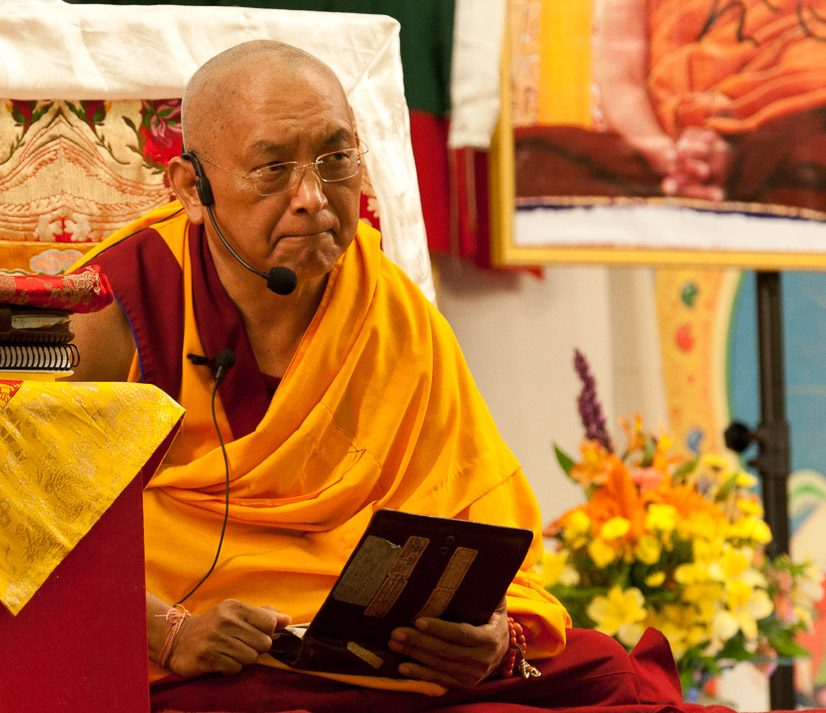
Second Wrong Concept
Looking at Samsaric Pleasure as Real Happiness
The second wrong concept is looking at samsaric pleasure as real happiness.
While samsaric pleasure is only suffering,
Because of looking at samsaric pleasure as real happiness and being attached,
I and all sentient beings have been born and suffered in samsara
Numberless times from beginningless rebirths up to now.
Samsaric pleasure is only suffering, but because of labeling it and looking at it as real happiness and then being attached, we have been continuously suffering in samsara from beginningless rebirths.
This is explained in Give Up Stretching the Legs, in the section “Give Up Entering Samsara.”
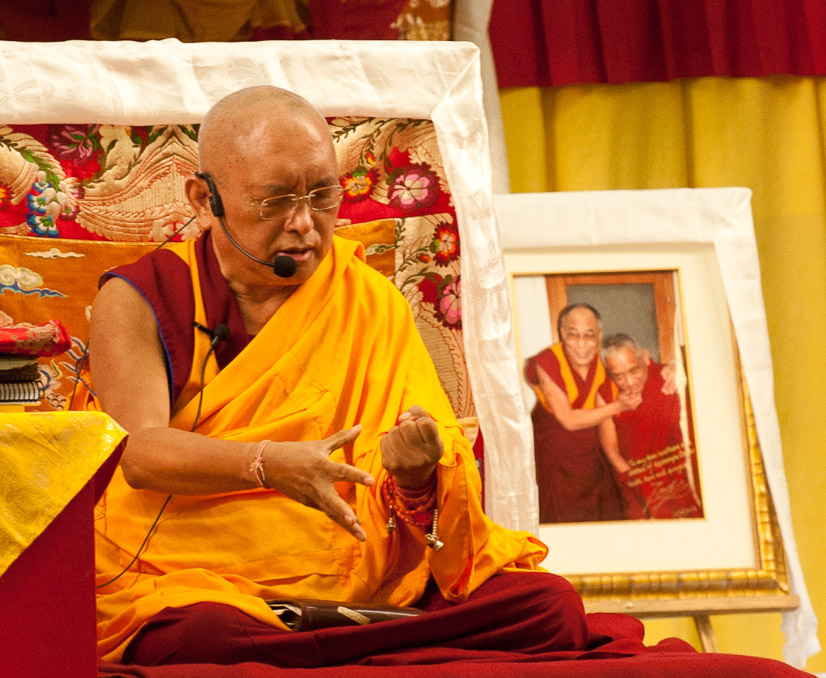
Third Wrong Concept
Looking at the Body as Clean
The third wrong concept is looking at the body as clean.
While this body is dirty,
Because of looking at the body as completely clean and being attached,
I and all sentient beings have been born and suffered in samsara
Numberless times from beginningless rebirths up to now.
This body is like a garbage can or a septic tank that collects all the waste from the toilet. Can you imagine being inside a septic tank? That is what this body is like. Nagarjuna said the body is “a container of thirty-six dirty things.”
Khunu Lama Rinpoche explained that before food is eaten, it is clean, but after going inside the body, it is dirty. Whether it comes out from the mouth, the ears or the holes in the lower part of the body, it is dirty. When food is put in a container or pot it doesn’t become dirty, but when it is put inside the body it becomes dirty. The reason it is dirty is because the inside of the body is dirty. This shows that the nature of the body is dirty.
Although this body is dirty, because of looking at it as completely clean and being attached, we have been continuously taking rebirth and experiencing suffering in samsara from beginningless rebirths up to now.
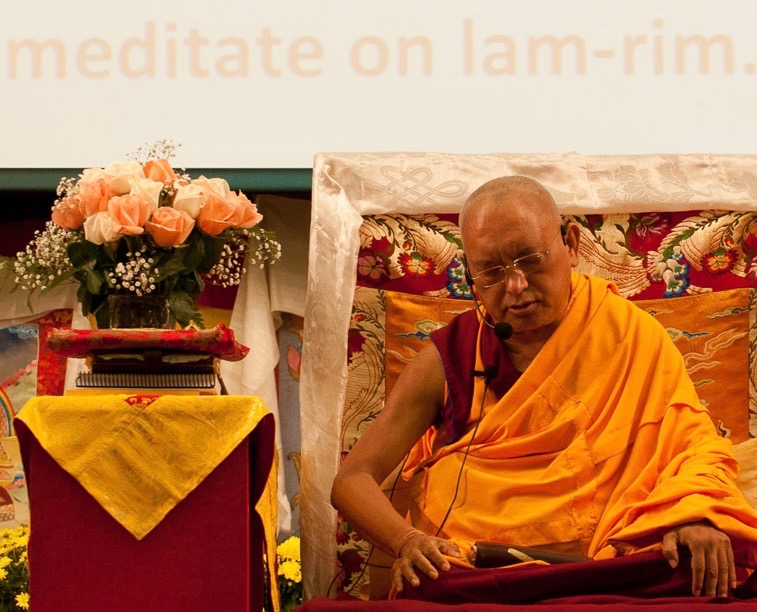
Fourth Wrong Concept
Looking at Compounded Phenomena as Permanent
The fourth wrong concept is looking at compounded phenomena as permanent.
While all compounded phenomena are in the nature of impermanence,
Because of looking at compounded phenomena as permanent and being attached,
I and all sentient beings have been born and suffered in samsara
Numberless times from beginningless rebirths up to now.

Our life, this I, these aggregates, our possessions, the people around us and our family members are all impermanent by nature. They are impermanent because they are compounded by causes and conditions and therefore under the control of causes and conditions. That is why everything decays and nothing lasts. Things change not only day by day, hour by hour, minute by minute and second by second, but even within each second. Geshe Lamrimpa from Tibet a mentioned that things change even within each second and that this is perhaps the subtlest impermanence.
It is because of not meditating, not being aware and not realizing that phenomena are in the nature of impermanence that we live our lives with the concept of permanence, believing that things are going to last for a long time and becoming attached to them. Then when things do change and death or decay comes to us or to someone in our family, it is an unbelievable shock. We have a nervous breakdown or go crazy.
For example, the first time I went to Malaysia I stayed at the house of a wealthy family because there was no center. Many lamas had stayed there previously and given the family Buddha statues. I heard that one day the son suddenly died and the father couldn’t stand it. He threw all the statues on the floor and broke them because he thought that Buddha had not taken care of his family. That is what happens when you don’t think about impermanence. You think things are permanent and that you and your family will live for a long time. Then when things suddenly change, even though that’s the nature of life, it is an unbelievable shock.
This is explained in Cutting the Concept of Permanence.
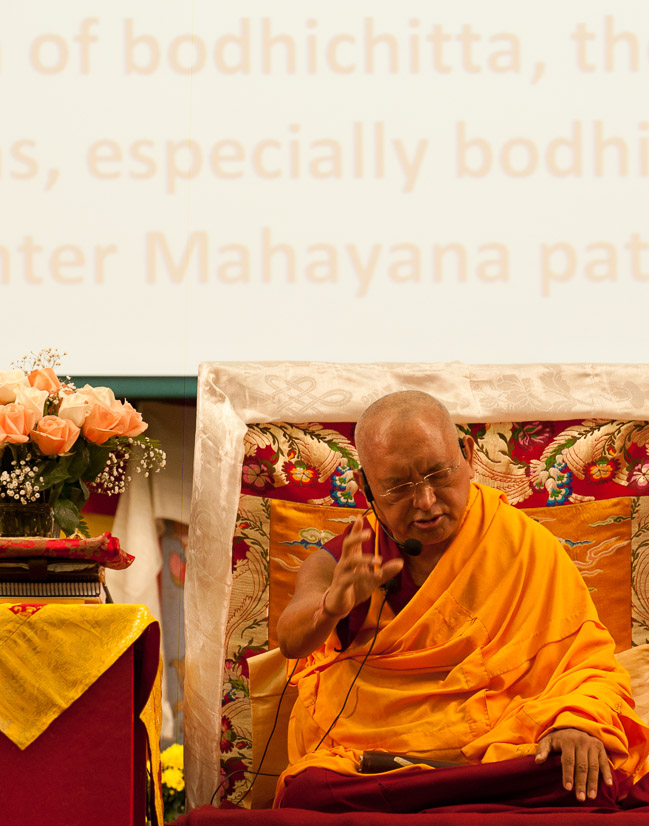
Letting Go of the I and Cherishing Others
Generating Bodhicitta
Because of being under the control of these four wrong concepts, we have been suffering since beginningless time and if we continue to follow these wrong concepts, we will experience all these unimaginable sufferings endlessly.
Just being free from the ocean of samsaric sufferings and its causes is not enough:
All sufferings, obstacles, misfortunes and undesirable things come from the self-cherishing thought, from cherishing the I.
It all comes from the self-cherishing thought, from cherishing the I. Therefore, the I is something to let go of.
All happiness—our past happiness from beginningless rebirths, present happiness, future happiness, liberation and enlightenment—comes from the good heart cherishing and wanting to benefit others, bodhicitta.
That means all our past happiness from beginningless rebirths as well as our present and future happiness up to enlightenment comes from others. It comes from numberless hell beings, hungry ghosts, animals, human beings, suras, asuras and intermediate state beings.
Let go of I and cherish others
Wow! Can you imagine that? All our happiness from beginningless rebirths came from the numberless sentient beings in each realm. Even without thinking of any other happiness, just that much kindness is unimaginable and depthless. There is so much to think about and feel. It is amazing how kind sentient beings are. Each one is unbelievably precious, kind and dear.
On top of that, all our present happiness comes from every hell being, hungry ghost, animal, human being, sura, asura and intermediate state being, therefore they are even more kind, precious and dear.
“Wow! Can you imagine? All our happiness from beginningless rebirths came from the numberless sentient beings.”
On top of that, all our future lives’ happiness, which is still only temporary happiness, comes from each of the numberless sentient beings in each realm, therefore they are much kinder, much more precious and dear.
On top of that, liberation from samsara comes from each of the numberless hell beings, hungry ghosts, animals, human beings, suras, asuras and intermediate state beings. Wow! Can you imagine? Now this is ultimate happiness, therefore they are unbelievably, unbelievably precious, kind and dear.

On top of that, enlightenment comes from every hell being, hungry ghost, animal, human being, sura, asura and intermediate state being. Wow! Now every sentient being is the dearest, kindest, most precious one in your heart. They are kinder even than Buddha, Dharma and Sangha, because Buddha, Dharma and Sangha came from the kindness of sentient beings. It is like you need food to survive and since the food has to come from a field, that field is very precious.
Therefore, whatever small service and benefit you can offer to anybody, whether it is a person or even an insect that is being eaten or drowning in water, is the happiest, most enjoyable thing in your life. Of course, if you can give great help it is good, but even if you can only offer some small help, still it is the happiest, most meaningful and most joyful thing. By seeing that sentient beings are the most precious, kindest and dearest ones in your life, you are unbelievably happy to do anything you can to help them.
Now think…
I am going to cause sentient beings to have not only the happiness of this life, but more importantly, the happiness of future lives; then even more importantly, ultimate happiness, liberation from samsara; and most importantly, enlightenment. In order to offer that service and benefit to others, I myself must achieve enlightenment. Therefore, I am going to take the eight Mahayana precepts.
The Motivations
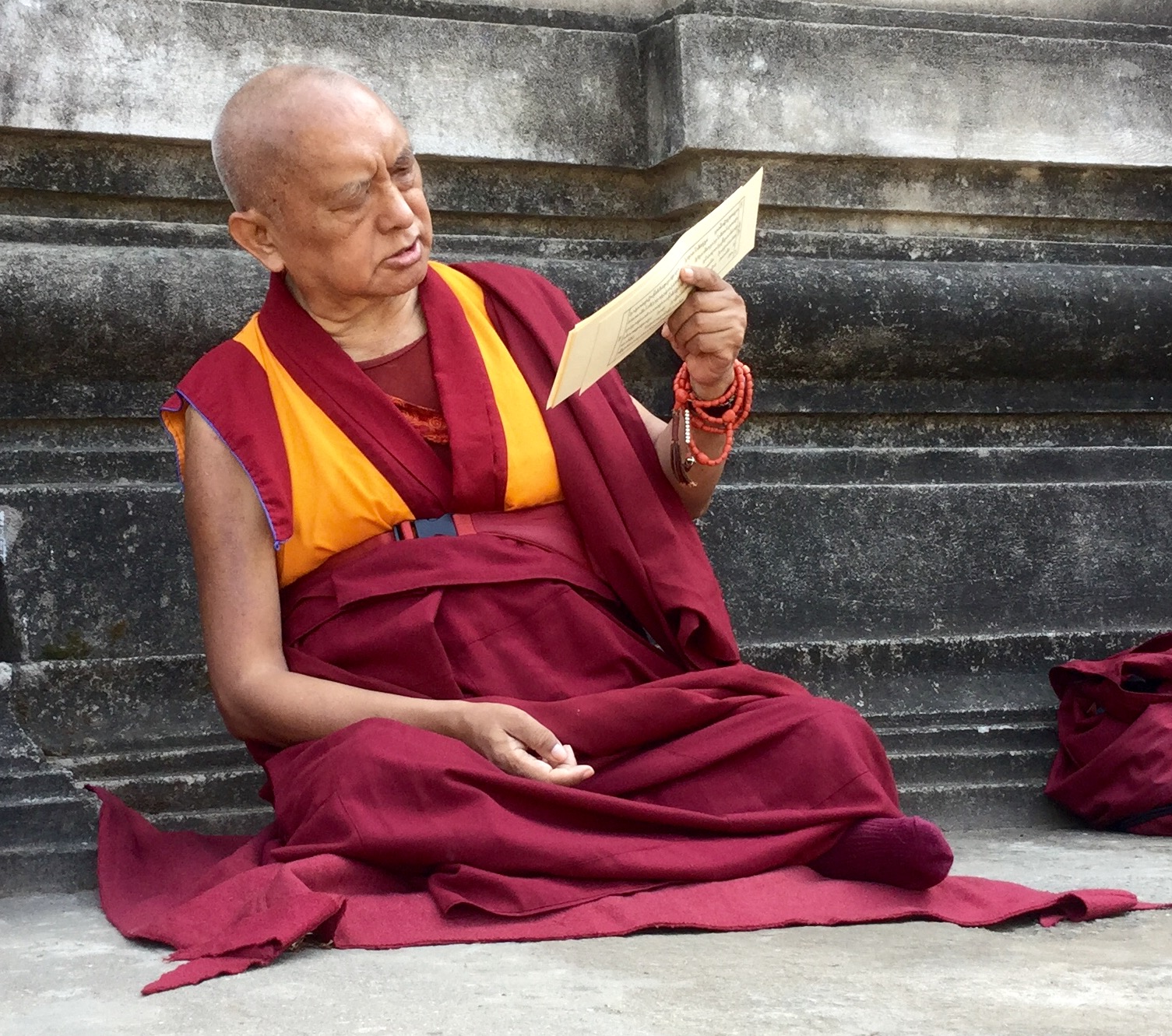
Click below to listen to long or short guided meditations from “Four Wrong Concepts.”
For a written copy of the meditations, please see Chapter 11 in your copy of the Bodhisattva Attitude or you can read them online here.
Watch This Entire Teaching
2009 Light of the Path: Session 5
Watch Rinpoche give these teachings

Learn More About These Teachings
“In the West, millions of people suffer from depression, but if you dedicate your life in the morning to numberless sentient beings, you will have unbelievable joy and happiness the whole day.”
Lama Zopa Rinpoche
Why is a bodhicitta motivation so important? What is the bodhisattva’s attitude? How can we keep our minds focused on bodhicitta throughout the day? Find out more about these subjects, learn the context of these teachings and read a summary presentation of each of the Bodhisattva Attitude sections here.
Additional Resources for Study

On The Eight Mahayana Precepts:
THE DIRECT AND UNMISTAKEN METHOD

For specific teachings on the eight Mahayana precepts and the actual ceremony, see The Direct and Unmistaken Method. An earlier edition of this title is also available to read online here.
TEACHINGS FROM THE VAJRASATTVA RETREAT

You can also find many additional teachings on the eight Mahayana precepts throughout Teachings from the Vajrasattva Retreat.
On Emptiness:
HOW THINGS EXIST

In this small book Lama Zopa Rinpoche starts by emphasizing the importance of compassion and universal responsibility and how to make life meaningful, then gives a brief explanation of the nature of the enlightened mind and how we can attain it, and finally offers an amazing and extensive explanation of emptiness, the ultimate nature of reality, analyzing the way various phenomena exist and teaching how to meditate on emptiness. Read How Things Exist here.
VIRTUE AND REALITY

This book contains methods for transforming everyday actions into the cause of enlightenment, anger into patience, and the ordinary view of phenomena as inherently existent into the wisdom realizing emptiness. It also includes several meditations led by Rinpoche, although everything in the book is a topic for meditation. Read Virtue and Reality here.
HOW TO SEE YOURSELF AS YOU REALLY ARE
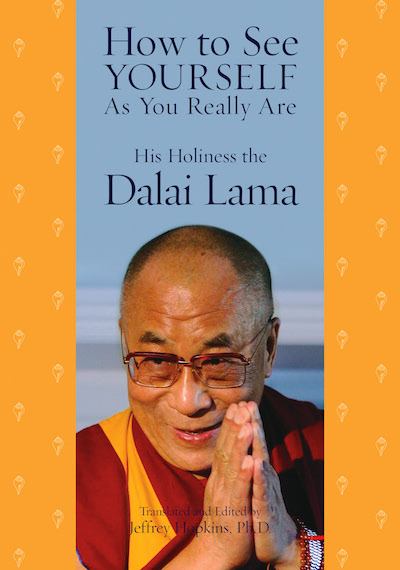
How to See Yourself as You Really Are explores practical ways to understand reality and can be found here.
Online Learning Center:
LIVING IN THE PATH
Continue to explore these Light of the Path teachings from Lama Zopa Rinpoche by enrolling in the FPMT Living in the Path study module called Taking the Essence: The Mahayana Precepts. Learn more here.
LYWA Heart Advice Series:
BODHISATTVA ATTITUDE
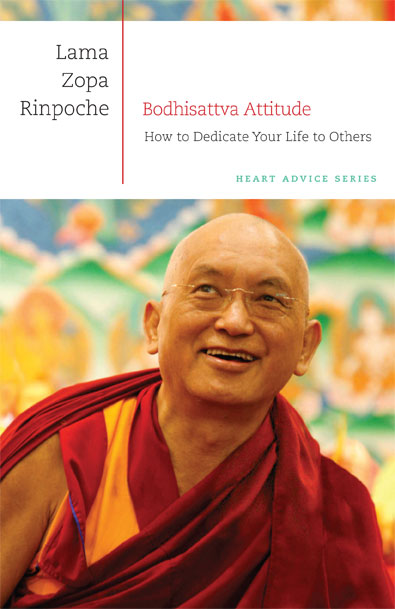
You can read the complete Bodhisattva Attitude on our website, order a free paperback copy and find links to download ebook versions here.
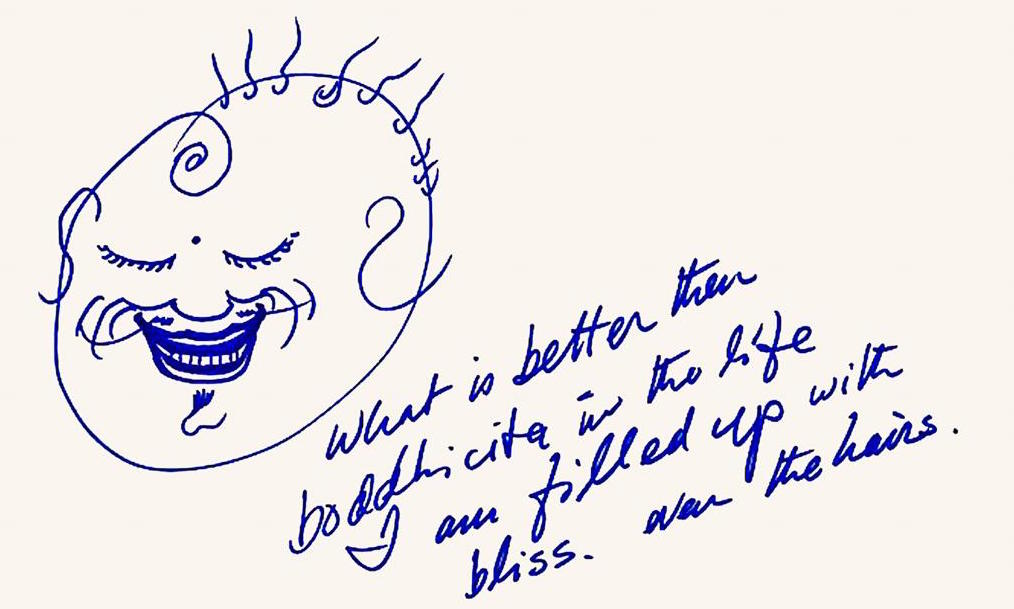
About the Heart Advice Series
The goal of the LYWA Heart Advice Series is to preserve and make available Rinpoche’s unique style and lineage of teachings and practices. Heart Advice is a series of core teachings — the “heart advice” — taken from the experiential instructions of Lama Zopa Rinpoche. You can read more about the goals of the Heart Advice Series here.
The main resources for the Heart Advice titles are Rinpoche’s major retreats, commentaries and transmissions given since 2008, although other Archive materials supplement these. Bodhisattva Attitude: How to Dedicate Your Life to Others is the first title in this series.
The Heart Advice Series is dedicated to the long life and perfect health of Lama Zopa Rinpoche, to his continuous teaching activity and to the fulfillment of all his holy wishes.
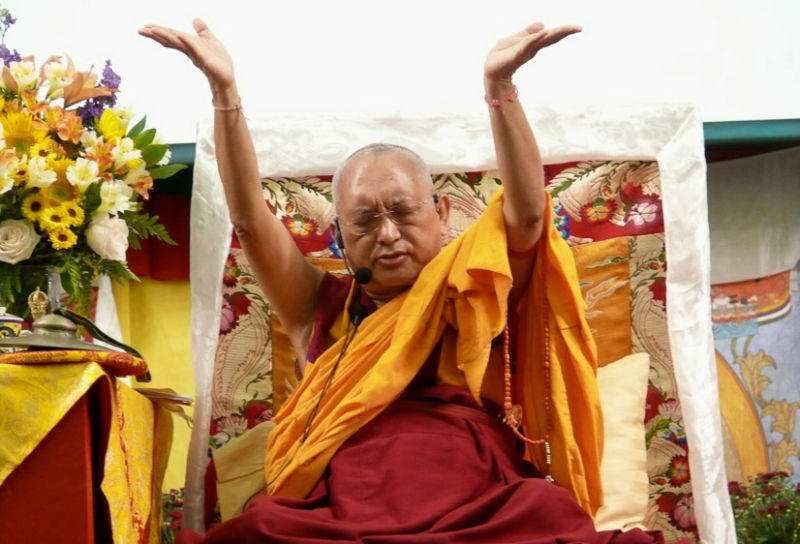
LYWA Multimedia

LYWA is so pleased to bring you this multimedia title based upon Lama Zopa Rinpoche’s Bodhisattva Attitude and edited by Ven Sarah Thresher and Megan Evart with technical assistance by Roy Harvey. We are also very grateful to our friends at FPMT for generously sharing their Light of the Path resources. It is our hope that this multimedia presentation will help to immerse you in these precious teachings of Rinpoche and will enhance your meditation and practice. By weaving FPMT and Archive resources together in this way we offer you the means to deepen your experience of the teachings – almost as if you had attended the teachings in person.
Four Wrong Concepts is the fourth in this series which began with Everything Depends on Your Attitude, followed by Cutting the Concept of Permanence and then Give Up Stretching the Legs. Future titles in this series will include Bodhisattva Attitude, Bodhicitta Mindfulness and Transforming a Suffering Life into Happiness. These titles add to our growing collection of multimedia offerings including Lama Yeshe’s Freedom – Courage – Realization and Lama Zopa Rinpoche’s The Merely Imputed I. Explore the complete collection of all LYWA multimedia titles here.
We welcome your questions, comments and suggestions!
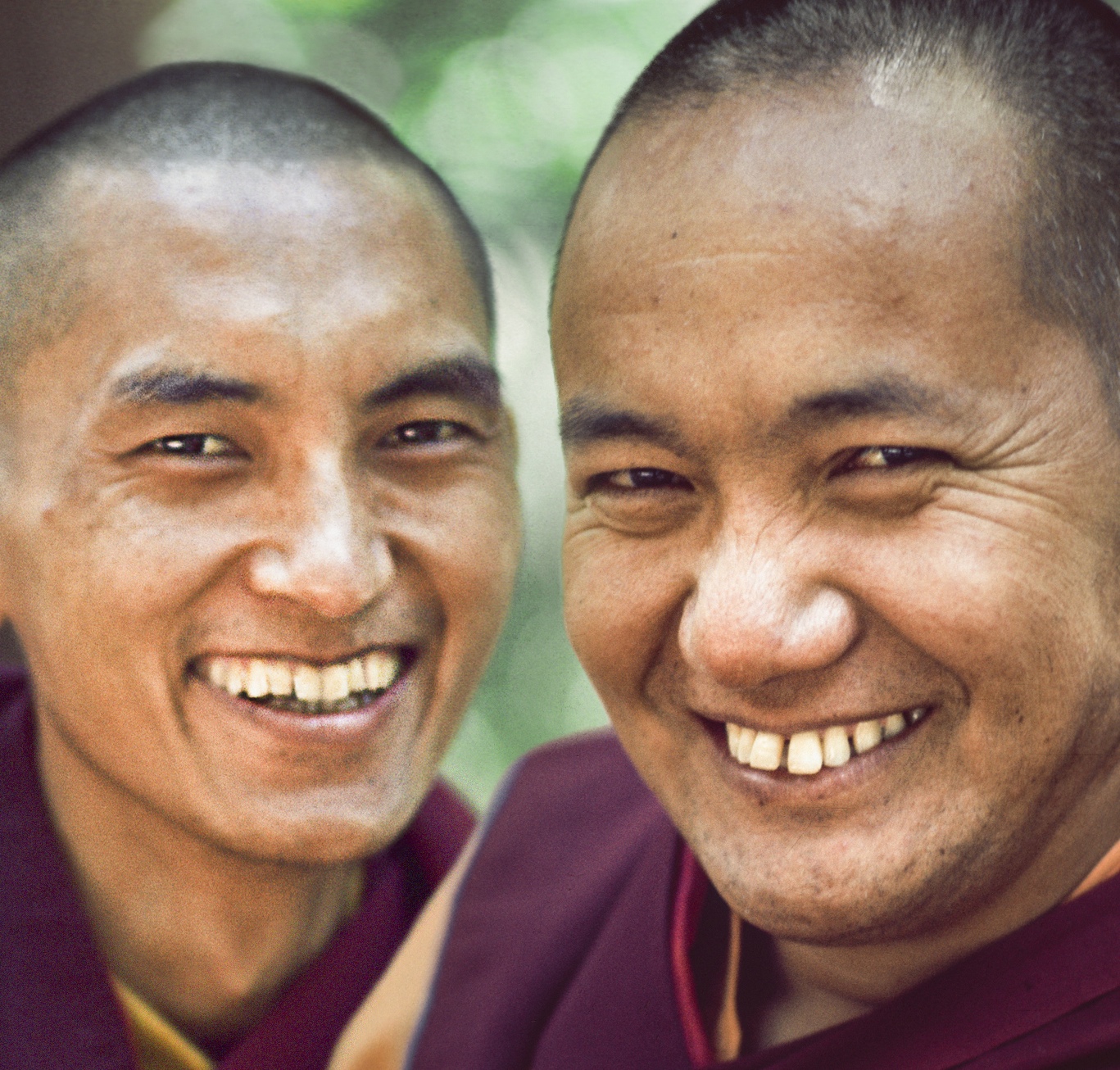
Lama Yeshe Wisdom Archive
These multimedia titles are made possible by the kind supporters of the Lama Yeshe Wisdom Archive who, like you, appreciate how LYWA makes the teachings of Lama Yeshe and Lama Zopa Rinpoche freely available in myriad formats, including on the Archive website for researching, listening, reading, downloading and ordering, shared daily with our social media communities and distributed worldwide as audio books, ebooks and free books. Please join us in sharing the Dharma with everyone everywhere for the happiness and benefit of all beings. Learn how by visiting us at LamaYeshe.com. Thank you so much and please enjoy this multimedia title.

Connect with LYWA
Facebook | Twitter | Instagram | Pinterest | Youtube
Sign up for the free monthly LYWA Dharma eletter!

